Permaculture paradise in coastal Waikato
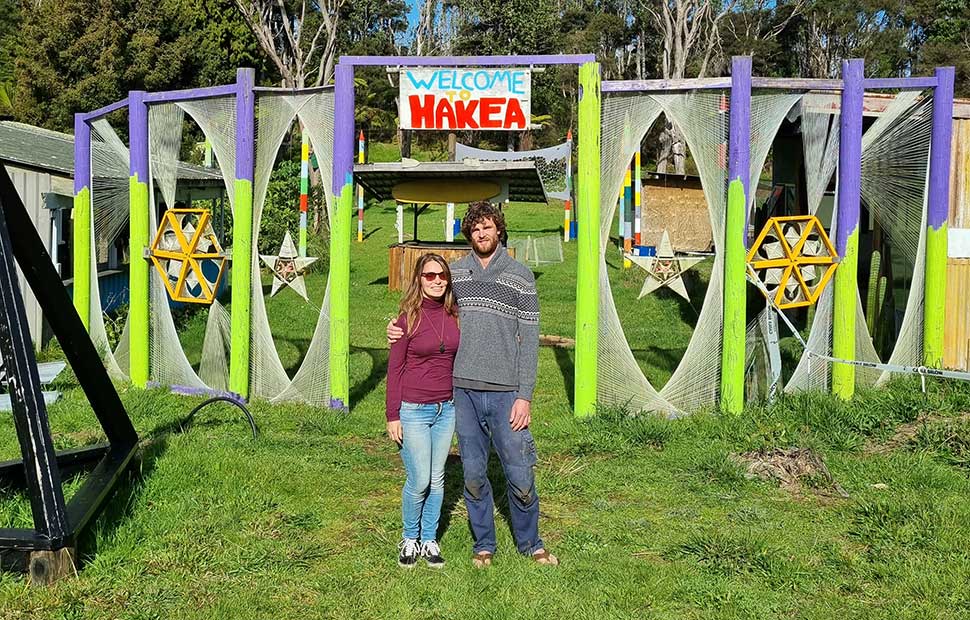
Words: Michael Andrew
In a stunning bush block in coastal Waikato, two young enthusiasts are channelling resilience and innovation to create a thriving hub of permaculture, arts and spirituality.
Listen to Michael’s chat with Dan and Merve on Episode 3 of The Pumpkin:
The rickety wooden gate on the roadside looks like it leads to nowhere. If you didn’t know what you were looking for, you’d miss it entirely. But once you’re beyond the threshold and winding down through the oasis of native bush, it becomes clear this is a very different kind of property. Artwork appears – vibrant, hand-painted signs with mystical designs placed alongside the driveway, as though you’re heading through an entrance to a secret music festival.
The road continues its meander, past a recycling centre, a farm shed and a tiny house community. After about 500 metres, the driveway ends in a beautiful north-facing glade filled with a ramshackle assortment of bach-like cabins and gardens. The last sign of all reads: “Welcome to paradise.”
This is Dan Whittington and Merve Yeşilkır’s Hakea – a secluded, off-grid bush retreat and permaculture farm among the native forest of Pakoka Scenic Reserve, 25 minutes south of Raglan. Overlooking Aotea Harbour, the 40-acre property is a hub of eclectic activity, boasting gardens, food forests, a campground, cabin accommodation, beehives, goats, chickens, wetlands and a regenerating forest. Perhaps unsurprisingly, it also features a homemade outdoor music venue complete with a stage and DJ booth.
For 29-year-old Merve (pronounced Marvay) and 30-year-old Dan, this motley array of offerings means they no longer need to work and can dedicate themselves to improving the land and pursuing self-sufficiency. They produce most of their food, the property runs on renewable energy, and, thanks to a knack for salvaging material, their expenses were less than $10,000 last year.
“We are at the beginning of our journey, but we just make it work,” says Merve. “Sometimes it’s just a mindset. When you change your mindset, to ‘I can do this’, things work out.”
“We’re doing everything we can to create different revenue streams,” says Dan, who was gifted the land from his family seven years ago. “It’s about not just focussing on one thing. We’re on CamperMate (an app for campgrounds), we have retreat rooms, we do workshops, we sell seedlings and trees. And quite luckily, all of them seem to be growing pretty well.”

With such a diverse array of facilities at Hakea, it’s difficult to believe the couple have only been living off the land for 13 months. While they have been residing there for the past seven years, it was only recently that both left full-time employment. Merve, a molecular biologist, was working in a lab in Hamilton until late 2021 and Dan, an engineer who was also working in Hamilton, lost his job during the COVID-19 vaccine mandates. Rather than letting the upheaval discourage them, they saw it as a sign they needed to put that old world behind them and embrace a new way of being.
It felt like it was meant to be,” Merve says. “We always wanted to live off the land and have that kind of lifestyle, but it didn’t seem very possible because we were making money, but we were also spending everything we made. We thought we weren’t ready, and then COVID happened. That’s when we started to realise, ‘we can do this’.”
“I feel like I’m way more relaxed now,” Dan says. “I’ve just got more time to put in on the land. To live off the land you need to be here full time, you want to be planting and you want to be milking daily and maintaining everything. It takes a lot
of time.”
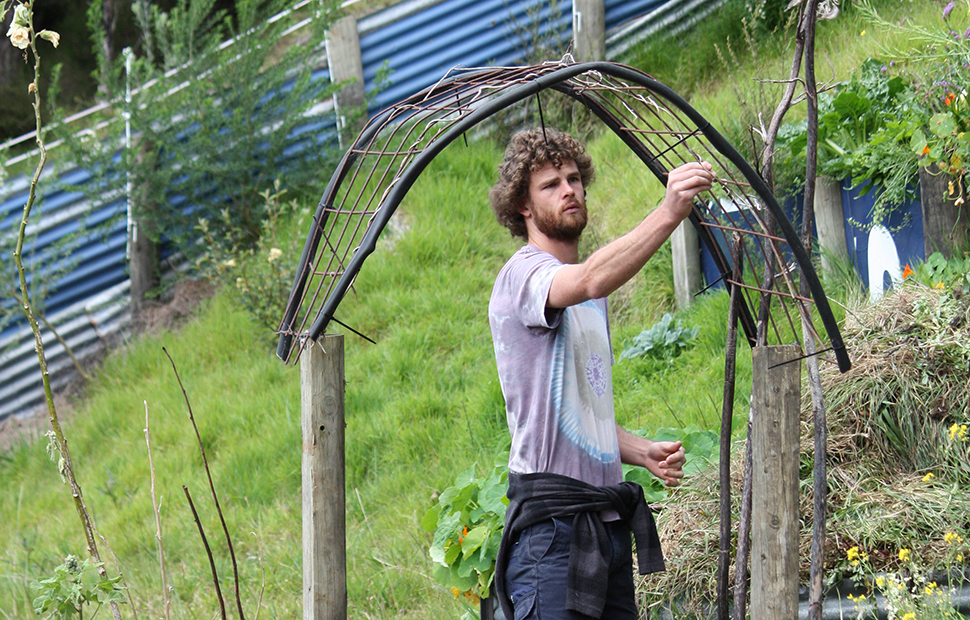
The Hakea supermarket
Since moving to Hakea, the couple have immersed themselves in the world of permaculture in an effort to create a more intuitive and bountiful connection with the land. Merve attained a permaculture design certificate at the Tui Community in Golden Bay and a Kai Oranga certificate under Hua Parakore principles – an indigenous food sovereignty initiative that promotes self-sustaining, low-input practices while working in harmony with nature.
Hakea is run on the same principles. Every scrap of resource is recycled back onto the land to create a closed-loop system, reducing inputs and costs and fostering an intimate, reciprocal relationship with the source of their food.
Combined with the land’s fertile volcanic soils and riparian coastal climate, this method has allowed Dan and Merve to cultivate extensive growing systems, with two food forests and vast gardens. One of the food forests is in a frost zone and has been planted with apples, pears, plums, peaches, prunes, apricots, blackberries, while the other on the northern slope is a subtropical area with bananas, cherimoyas, avocados, vanilla passionfruit, pomegranate, figs and pineapples. Meanwhile, the gardens are bulging with perennials, medicinal herbs, and heavy self-seeders, as well as feijoas, avocados, limes, and grape and blackberry vines. All told, there are over 100 different varieties of fruit and nut trees, support trees, shrubs, vines, berries, bird and bee trees, and natives helping sustain the ecosystem around the property.
Considering, also, the honey, chickens and goats, which are used for daily milk and occasional meat, the farm produces such abundant food that Dan refers to it as their own “personal supermarket”.
“My style of gardening is called ‘forest gardening’,” says Merve. “I let things finish their cycle. There’s a lot of things in the garden that self-seed, so the garden is never empty – there is always something to eat.”
Creative intelligence
Along with their aptitude for growing, Dan and Merve possess something unique that makes designing and managing the infrastructure of such a large property far more effective – their technical knowledge.
With training in science and engineering, the couple are able to combine their natural creativity and resourcefulness with formal skills, often innovating bespoke solutions to specific problems for very little cost. Around their food forest and garden area, they have created the “great wall of Hakea” – a 200m-long possum-proof fence made from old roofing iron, salvaged from the Raglan Harbour View Hotel. Topped with electric wire, the fence has proved incredibly effective at keeping out possums and protecting the thriving produce within the growing area.
Then there are outdoor toilets; a standard composting design built out of recycled stainless steel and pool liner plastic, which they’ve tweaked and engineered to speed up decomposition and ensure every last bit of human waste can be collected, processed into compost and used somewhere on the property. Water from the wash basin is plumbed into the same reservoir as urine, diluting it before it’s gravity-dispersed through pipes to fertilise the subtropical food forest. The storage chamber for faeces has been fitted with a metal grill to maintain optimum moisture levels and worm access, while a fan and underground T-section allows air to circulate around the whole system, accelerating the aerobic process. The design is so effective that it works without any intervention, even over winter, turning faeces into a rich compost that can be applied as a nourishing mulch in the vegetable gardens.
“I’ve read that one person’s pee can fertilise a huge area over their lifetime,” Merve says. “And it’s now becoming more important because the war in Ukraine is causing a shortage of fertiliser. So people are actually starting to look into urine as a replacement.”
“I’m really quite proud of the composting toilet,” Day says. “It took about five years to get it perfect. It’s so sustainable and it’s making such good compost. People think waste (from toilets) is a problem. But it’s actually our solution. And now that we’ve got retreat rooms and the campground, more people are using our facilities and we’re getting even more compost.”
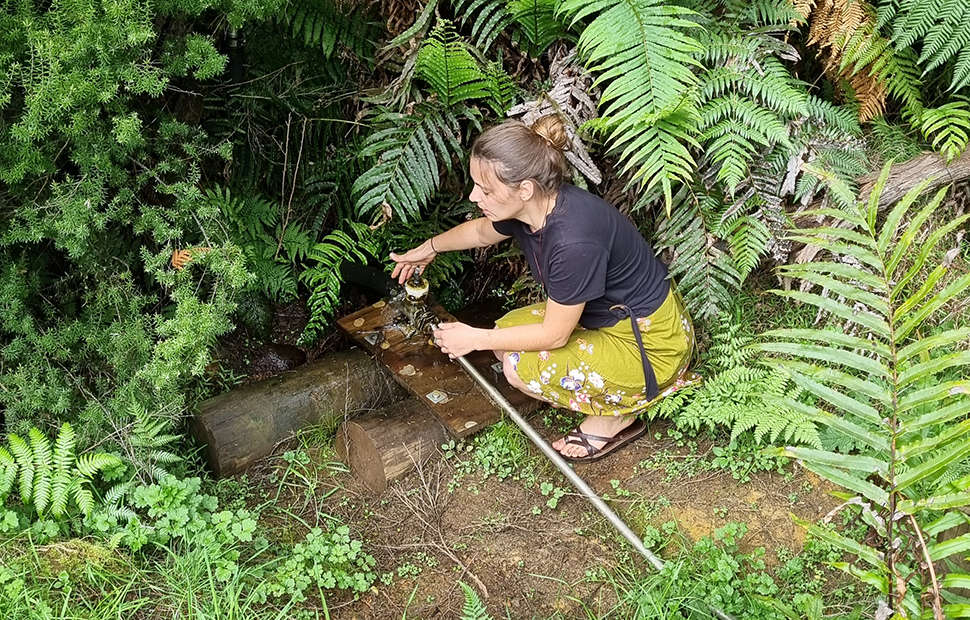
The power of water
While the composting toilet sits in a position of daily prominence, Hakea’s most prized piece of technology is hidden away in the bush, discreetly yet reliably sustaining the entire property. Near the bottom of the valley, far below the houses, sits the ram pump: a self-driven contraption that uses hydropower to deliver water uphill without any other energy connection.
Dan’s dad, Dave, installed the system 30 years ago. Water from a low-lying spring is sent to a collection tank, and from there it is gravity-fed down an angled pipe to the ram pump itself. In simple terms, the kinetic energy of water triggers a waste valve to close, causing a surge of pressure known as a water hammer. This pressure opens a delivery valve and forces water to flow into the pipe that delivers it uphill to the toilets and house. The pressure releases, forcing the waste valve open and the process to start all over again. From the outside, all this looks like a single piston constantly lifting and falling with a steady bang, around 100 times per minute.
“In technical terms, all you need is three litres of water a minute, and a drop of three metres by eight metres hypotenuse for it to work,” says Dan. “It’s such a cool technology, always running in the background. It uses nothing and we’re getting 1000 litres a day for free. Anyone could build one – all you need is some scrap metal.”
“The pump is similar to a heartbeat – it’s supposed to be 80 to 120 pumps per minute,” Merve says. “If it’s too fast or too slow, you know something is wrong. For me the logic of it is very simple but so amazing. It’s basically using the water’s own energy to pump the water uphill. It sounds like magic, but it’s science. And it works very well.”
Dave bought the pump at Fieldays in the 1990s. While it had stopped working when Dan and Merve came to live at Hakea, they very quickly began restoring it, cleaning the valves, replacing the rusted galvanised steel piping with stainless steel, and adding a few bespoke modifications to improve its efficiency.
“At first we had the idea of getting a solar-powered pump, but then we realised it was pointless,” Merve says. “The old system was there, and we had guidance from Dave and his friends. But to create the new one we had to do a lot of research to see how this system works because you need a certain drop to pump water to a certain height. So we had to get our heads around it.”
“Dad and his friends originally installed the first system and ran all the pipes,” adds Dan. “They taught us the infrastructure and we’ve rebuilt it as stainless steel, making it more sustainable. I’m really proud of the collaboration.”
The couple’s appetite for sustainability is so insatiable that they’ve decided to eventually eliminate their use of LPG gas as well. Although they use a gas bottle for heating water, they plan to install an alkathene pipe system on the roof to provide solar-heated hot water for cleaning and cooking. All other cooking they’ll do outside over their wood-fired stove.
“We are still using gas but I think we are always questioning what is a renewable resource and how can we replace what we are using with something better,” Merve says. “We are always thinking like that.”
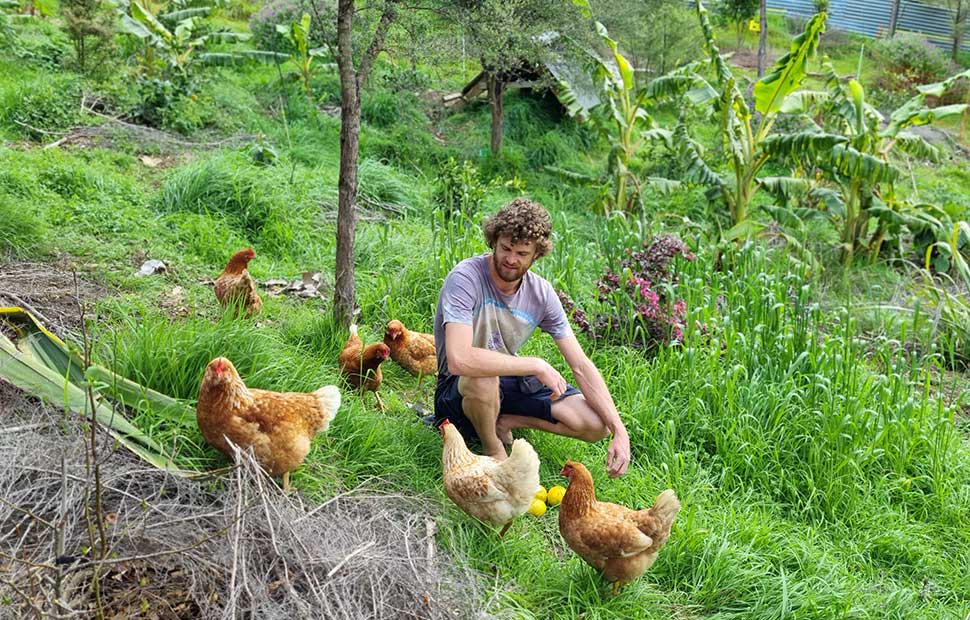
Ancestral wisdom
Despite being a scientist with training in permaculture design, some of Merve’s most valuable knowledge comes not from her formal education but from the ancient husbandry skills that were passed down from her mother and ancestors in rural Turkey. Growing up in a mountainous village in the northern Black Sea region, Merve was surrounded by a traditional form of subsistence farming that relies on whatever resources each season makes available. The village resides in one place during winter, then migrates up to the midlands for grazing in spring and then the highlands in summer; wherever the climate yields the best pasture. Although Merve moved to the city for school when she was 10, she absorbed much of what she saw in those early years. Her natural instinct for growing is reemerging
at Hakea.
“In my village, everyone helps each other. People grow their own food, make their own yoghurt and butter, the houses are made of cow dung and grass, so I feel like a lot of knowledge was passed down to me, especially from my mum. She’s a woman of the land, she knows so much. She’s the goddess of everything. “I feel it’s important to mention that permaculture has its roots in indigenous wisdom. My mum knows nothing about permaculture, but everything she does has that logic – that traditional knowledge. They do so many things instinctively, because they have those resources, and have been living that way for centuries.”
During the winter of 2022, the couple went back to Merve’s village in Turkey to visit family and learn better ways of living with the land. Dan says he was amazed at the degree to which resources are used to provide auxiliary benefit. Although the goats and cattle are allowed to range freely during the day, at night they’re sheltered under the houses to protect them from bears and wolves. This method also provides a form of passive heat for the people living in the house above and an easy way of collecting manure for the gardens.
“It’s very sustainable, they can only farm as many animals as they can fit under their houses,” Dan says. “We’re learning from them all the time. We contact them whenever we have questions.”
“Last time we were there we learned a lot about grafting and about the tools they use, which we don’t in NZ,” says Merve. “And I guess we learned more about having that circular system of resources. My mum can’t tell me how she knows it, she just knows it. It’s like a collective consciousness that everyone takes part in from children. There’s this circle.”
Community and art
There’s little doubt Dan and Merve have the abilities, vision and will to maximise the growing potential of such a large property. But the couple know that they would never be able to do and grow everything themselves. That’s why, although they’re technically self-sufficient, they rely a lot on the community to diversify their food options. They’ll barter goat’s milk and produce for many of the foods they can’t grow themselves, and much of their meat and fish comes from Dan’s friend – a keen hunter who’ll often bring down a deer or wild pig in the Pakoka Scenic Reserve adjacent to Hakea.
“Dan’s dad goes fishing and gives us fish and we give him seedlings or something in return,” says Merve. “Doing everything is impossible, that’s why community is important, supporting each other. Because we do certain things and other people do certain things and we can help each other.”
That applies to jobs at Hakea as well. They host a consistent retinue of interns throughout the year to help maintain the place, and they’re always employing the help of friends to assist with jobs around the land, such as the creation of composting toilets, the workshop area and all the artwork.
Many of the workshops hosted at Hakea are an opportunity for the members of the local permaculture and arts communities to come together and collaborate on inspiring projects in which they can share and learn new skills.
“We didn’t become like this overnight, we had to talk to a lot of people and make a lot of mistakes,” says Merve. “It’s just about talking to people and getting lots of opinions.”
The self-sufficient nature of Hakea means only certain people – those who appreciate the genius of composting toilets, for instance – are drawn to the land. That suits Dan and Merve just fine. “That’s a big thing for us: having the right people that are like-minded and feel the same way as we do,” says Dan.
Early next year, the couple will host the Hakea gathering: a weekend mini-festival with 40 co-creators, 18 different workshops, an educational children’s zone, and up to 130 guests who will camp in tents and campervans at the property’s campground near the workshop rooms and music stage. Merve says it’s a way to continue using the land as a space to bring people together for creativity and inspiration, which was the vision ever since Dan took it over.
“Hakea was always a gathering place,” says Merve. “Dan’s parents gifted him the land as he was kaitiaki (caretaker) and he envisioned something more than a beef and sheep farm. With help from his friends, he invested countless hours and lots of money to set it up and honour his parents’ hard work.
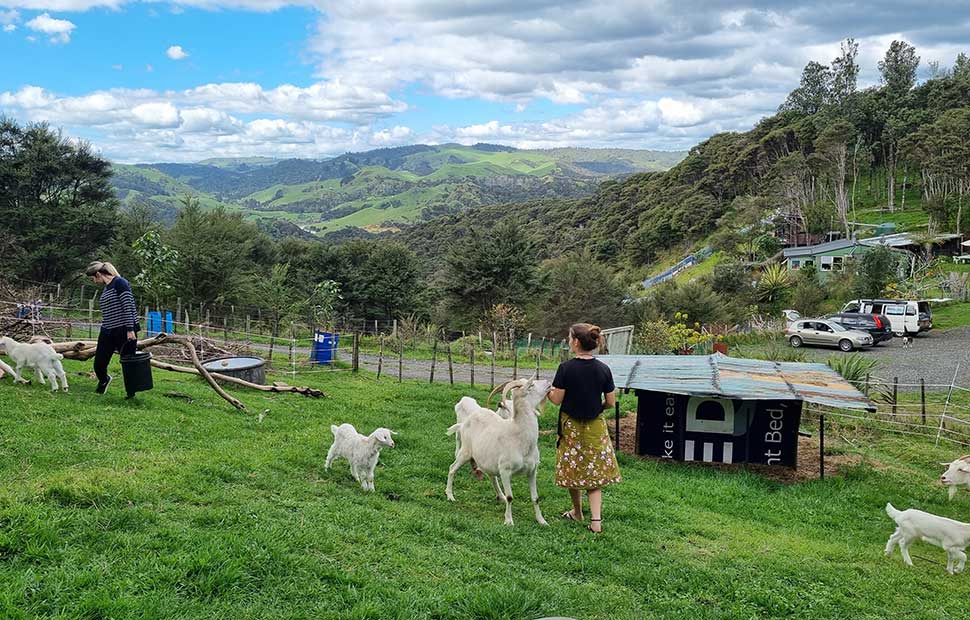
Living the life
On paper, Hakea sounds like paradise. But the reality is it’s an enormous undertaking to run such a large property under permaculture principles – even with the help of the community. Like everyone else in similar positions, Merve says they need to be tremendously resilient to pursue such a life where failure is a daily phenomenon.
“You do fail. It’s just nature, you know? Some things die and some things grow. It’s about being resilient, flowing and adapting to whatever is happening on the land or in our personal lives. It’s just about being part of the journey.”
“I don’t know how many mistakes I’ve made,” Dan says. “I’ll be sleeping and wake up thinking ‘oh no I’ve done something wrong. I’ve totally screwed up, what was I thinking?’ But then we adapt to make it better.”
The pair have to be very mindful about keeping their outgoings low, and making enough money from the land where they can. Seldom is anything bought new, and a lot of time is put into diversifying the land’s revenue streams so that if one dries up, there’s a steady trickle elsewhere. One example is Landshare, an online directory that allows them to rent parts of their land to tiny house owners.
“Landshare is very stable,” says Merve. “People are always here so we have this safety net. We also really like helping these people – they’re really happy to be on the land and just live their dreams basically.”
“We make it good for both sides,” Dan says “We charge just enough to maintain it so they’re not left with a big bill at the end of the week. They can have a good life as well.”
For any purchases, Trade Me and Raglan’s Buy Sell Trade Facebook page are key resources. If anything is too expensive, such as international flights, their strategy is to simply wait until a cheaper option comes up.
“If you wait, things will come,” says Dan. “You just have to have a bit of time.”
Some people might consider such a lifestyle far too tedious and uncomfortable to be anything more than a brief novelty. But Dan and Merve know it’s all part of the unique path that allows them to live and work in such a special place, fostering deep, authentic and sustainable connections with the land. Does that mean they’re going to start keeping their goats under the house for warmth?
“We definitely would if we needed to!” says Dan.
Love this story? Subscribe now!
 This article first appeared in NZ Lifestyle Block Magazine.
This article first appeared in NZ Lifestyle Block Magazine.
